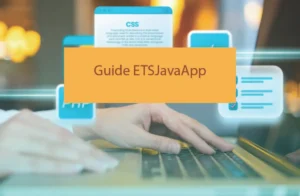The “Guide EtsJavaApp” is here to help you learn how to create amazing applications using Java. This guide will show you step-by-step how to get started with Guide EtsJavaApp and make your own apps. If you’re new to Java or ETS, don’t worry—this guide is perfect for you!
In this blog post, we will explore how the Guide EtsJavaApp works and what makes it a great tool for building software. We’ll cover everything from setting up your computer to writing your first lines of code. Let’s dive into the world of Java with the help of Guide EtsJavaApp!

What is Guide EtsJavaApp
The “Guide EtsJavaApp” is a helpful tool for making Java applications. It helps you build software by providing easy steps and instructions. This guide is designed for beginners who want to learn Java and use it to create apps.
In simple terms, Guide EtsJavaApp is like a roadmap for your Java projects. It tells you what tools to use and how to set everything up. By following this guide, you can make sure your Java app is built correctly and works well.
Using the Guide EtsJavaApp, you will learn how to write code and test your software. This tool is great for anyone new to programming. It makes learning Java fun and straightforward, so you can start creating your own apps in no time.
Why Use Guide EtsJavaApp for Java Projects
Guide EtsJavaApp is a fantastic choice for Java projects because it simplifies the development process. With this guide, you don’t need to worry about the complex parts of coding. It breaks everything down into simple steps that are easy to follow.
When you use Guide EtsJavaApp, you get a clear path to building your Java application. This means you can focus on creating great software without getting stuck. The guide helps you learn as you go, making the whole process much easier.
Moreover, Guide EtsJavaApp offers tips and tricks to improve your coding skills. It shows you best practices and how to avoid common mistakes. This makes it a valuable resource for both beginners and those with some experience.
How to Set Up Guide EtsJavaApp on Your Computer
To start with Guide EtsJavaApp, you need to set it up on your computer. First, you must install the Java Development Kit (JDK). This is the tool that lets you write and run Java programs.
Next, download and install an Integrated Development Environment (IDE). IDEs like IntelliJ IDEA or Eclipse are perfect for coding with Guide EtsJavaApp. They help you write code more efficiently and manage your project.
After installing the JDK and IDE, configure your tools to work together. Make sure everything is set up correctly so you can start using Guide EtsJavaApp. This setup will ensure you have a smooth experience as you begin developing your Java application.
Getting Started with Your First Guide EtsJavaApp Project
Starting your first project with Guide EtsJavaApp is exciting! Begin by creating a new project in your IDE. This is where you will write your Java code and organize your files.
Next, set up the project structure according to the guide. This means creating folders and files to keep everything neat. Follow the instructions in Guide EtsJavaApp to ensure your project is well-organized.
Now, write your first Java class. This is where you’ll start coding the basic functions of your app. With Guide EtsJavaApp, you’ll learn how to create classes and methods, making your first project fun and educational.
Understanding the Basics of Guide EtsJavaApp
The basics of Guide EtsJavaApp are simple to understand. It helps you learn how to write Java code and build applications. The guide covers essential topics like classes, methods, and objects in Java.
In Guide EtsJavaApp, you will find easy-to-follow examples that teach you how to code. These examples show you the core concepts of Java and how to use them in your projects. Learning these basics is crucial for creating successful applications.
The guide also explains how to debug your code. Debugging is finding and fixing mistakes in your program. With Guide EtsJavaApp, you’ll learn how to find errors and make your code run smoothly.
How to Write Simple Code with Guide EtsJavaApp
Writing simple code with Guide EtsJavaApp is a great way to start learning Java. Begin by creating small programs that perform basic tasks. This helps you understand how Java works and how to use it effectively.
The guide provides clear examples of simple code snippets. These examples show you how to write code for different functions, such as printing text or performing calculations. By practicing with these examples, you’ll get better at coding.
Guide EtsJavaApp also offers tips for writing clean and readable code. Clean code is easy to understand and maintain. Following these tips will help you write code that is both functional and easy to read.
Connecting Guide EtsJavaApp to a Database
Connecting Guide EtsJavaApp to a database is an important step in building apps. Databases store and manage your app’s data. To connect your application, you’ll need to use tools like JDBC or Hibernate.
First, set up your database connection by following the guide’s instructions. This involves configuring your database settings and writing code to connect to it. Once connected, you can start working with your data.
Using Guide EtsJavaApp, you’ll learn how to perform basic database operations like adding, updating, and deleting records. This knowledge is essential for creating apps that manage data effectively.
Adding Advanced Features with Guide EtsJavaApp
Adding advanced features to your Guide EtsJavaApp project can make it even better. Explore how to include complex functions, such as integrating with external services or using Java frameworks.
Guide EtsJavaApp shows you how to add features like API integrations. This means you can connect your app to other services and expand its functionality. Learn to use frameworks like Spring for even more advanced capabilities.
The guide also covers error handling and logging. These features help you manage and track problems in your app. By incorporating these advanced features, you’ll create a more robust and professional application.
Testing Your Guide EtsJavaApp Application
Testing is crucial for ensuring your Guide EtsJavaApp application works correctly. The guide explains how to perform different types of tests, such as unit testing and integration testing.
Start by writing unit tests to check individual parts of your code. Unit tests help you find and fix issues in small pieces of your application. Guide EtsJavaApp provides examples and tools for writing these tests.
Next, conduct integration testing to ensure all parts of your app work together. This step helps you verify that different components of your application function as expected. Testing your app thoroughly ensures it runs smoothly for users.

Deploying Your Guide EtsJavaApp Project
Deploying your Guide EtsJavaApp project means making it available for users. The guide helps you understand the deployment process, including options like on-premises or cloud deployment.
Choose the best deployment method for your app. On-premises deployment means installing the app on your own servers, while cloud deployment involves using cloud services. Guide EtsJavaApp provides tips for both methods.
Prepare your app for deployment by ensuring it meets all requirements. Follow the guide’s advice on setting up and configuring your application for a successful launch. Proper deployment ensures your app is ready for users.
Troubleshooting Common Guide EtsJavaApp Issues
Troubleshooting is an important skill when working with Guide EtsJavaApp. The guide helps you identify and fix common issues that may arise during development.
Learn how to resolve problems like code errors or connection issues. The guide offers solutions and tips for overcoming these challenges. By following these troubleshooting steps, you can keep your project on track.
Guide EtsJavaApp also provides advice on optimizing your code. This helps you improve performance and avoid problems in the future. Effective troubleshooting and optimization ensure your app runs smoothly and efficiently.
Tips for Getting the Most Out of Guide EtsJavaApp
To get the most out of it, follow these helpful tips. Start by exploring all the features and tools offered by the guide. This will help you make the most of your Java development experience.
Regularly practice coding and use the guide’s examples to improve your skills. The more you practice, the better you’ll become at using it. Don’t hesitate to experiment with new ideas and features.
Finally, stay updated with any new versions or updates to it. The guide may include new tips or tools that can help you enhance your projects. By keeping up with the latest information, you’ll ensure your development skills stay current.
Key Features of Guide EtsJavaApp
Guide EtsJavaApp offers several key features that make Java programming easier. One important feature is its step-by-step instructions, which guide you through each part of building a Java application. This makes it easier to understand and follow along, especially if you’re new to coding.
Another feature is the built-in examples and templates. These provide a starting point for your projects and help you learn by doing. With these examples, you can see how real Java applications are built and use them as a model for your own work.
it also includes tips and best practices to improve your coding skills. It helps you write clean and efficient code, which is crucial for developing high-quality applications. These features combined make it a powerful tool for anyone looking to learn Java and build applications effectively.
Best Practices for Using Guide EtsJavaApp
When using Guide EtsJavaApp, following best practices can make your coding experience smoother. Start by carefully reading the instructions provided. This ensures you understand each step before moving on, which helps prevent mistakes.
Organize your project files and code according to the guide’s recommendations. Keeping your code well-organized makes it easier to manage and debug. it provides tips on how to structure your code, so make sure to follow them.
Regularly test your code as you build your application. This helps you catch and fix problems early. tiemphasizes the importance of testing, and following this advice will help ensure your application works correctly and efficiently.
Troubleshooting Common Issues with Guide EtsJavaApp
While using Guide EtsJavaApp, you might run into some common issues. One frequent problem is setting up the development environment. Make sure you’ve installed all necessary tools like the JDK and IDE, and check that they are properly configured.
Another issue could be errors in your code. it offers troubleshooting tips to help you find and fix these errors. Using these tips can help you understand what went wrong and how to correct it.
Sometimes, you might face challenges with running your application. If your app doesn’t work as expected, check the guide for advice on debugging and resolving these issues. Following the guide’s troubleshooting steps will help you get your application running smoothly.
Enhancing Your Guide EtsJavaApp Skills
To enhance your skills with it, practice regularly and work on different projects. The more you code, the better you’ll become. Try creating various types of applications to expand your knowledge and experience.
Explore advanced features and techniques offered by the guide. This might include learning about Java frameworks or integrating external services. By diving into these advanced topics, you can improve your coding skills and build more complex applications.
Join online communities or forums related to Java programming. Engaging with others can provide additional support and insights. Sharing your experiences and learning from others will help you grow as a Java developer.
Exploring Advanced Features of Guide EtsJavaApp
Guide EtsJavaApp doesn’t just cover the basics; it also dives into advanced features. One such feature is the integration of external libraries and tools. This allows you to extend the functionality of your Java applications by adding new capabilities.
Another advanced feature is the use of design patterns. These are proven solutions to common coding problems and help you create more efficient and maintainable code. it explains how to implement these patterns effectively in your projects.
Additionally, the guide covers performance optimization techniques. These techniques help you make your applications run faster and use resources more efficiently. By learning and applying these advanced features, you can build high-performance Java applications with it.
Deploying Your Application with Guide EtsJavaApp
Deploying your application is an important step after development. it provides guidance on how to prepare your app for deployment. This includes packaging your code and setting up the necessary environment.
You can choose between different deployment options, such as cloud services or on-premises servers. The guide explains the pros and cons of each option, helping you make the best choice for your needs.
Once your application is deployed, it also offers tips on monitoring and maintaining it. This ensures your application continues to run smoothly and efficiently. By following these deployment and maintenance steps, you can ensure the long-term success of your Java applications.

Conclusion
Guide EtsJavaApp is a fantastic tool for anyone learning Java and building applications. It helps you step by step, from setting up your computer to creating your first project. By following this guide, you can learn how to code and build cool apps with ease.
Using it makes Java programming fun and simple. With its clear instructions and helpful tips, you’ll become better at coding in no time. Keep practicing and exploring, and you’ll soon be making amazing Java applications on your own!


